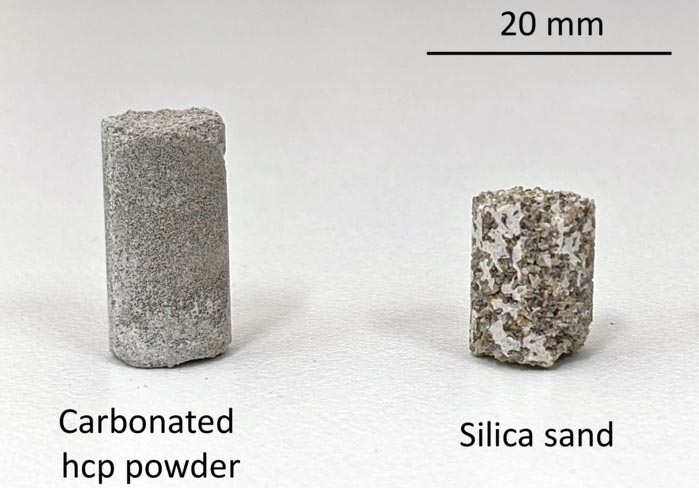A concrete solution

Two samples of calcium carbonate concrete, one using hardened cement paste (left) and the other using silica sand. Both raw materials are common construction and demolition waste products.
Credit: © 2021 Maruyama et al.
Recycled concrete and CO2 from the air are made into a new building material.
A new kind of concrete could reduce emissions from the construction industry. Calcium carbonate concrete is made from waste concrete and carbon dioxide from the air or industrial exhaust gases. It shows promise as a future construction material, especially in places where natural resources are limited.
The modern world is built from concrete. Every tall building in every city on Earth uses the durable and versatile material to give it shape and strength. The concrete industry therefore is enormous, and this comes at a cost: It is estimated that around 7% of the world’s carbon dioxide emissions come from the manufacture and use of cement, the main component of concrete. And a large proportion of this 7% is due to the necessary use of calcium, which is usually obtained by burning limestone.
A new way to reduce emissions levels caused by concrete use has been proposed and proven to work by Professor Ippei Maruyama and C4S (Calcium Carbonate Circulation System for Construction) project manager Professor Takafumi Noguchi, both from the Department of Architecture at the University of Tokyo. They have found a way to take waste concrete and captured carbon dioxide, and combine them in a novel process into a usable form of concrete called calcium carbonate concrete.
Inspired by the way some aquatic organisms harden into fossils over time, Maruyama wondered if the same process that forms hard calcium carbonate deposits from dead organic matter could be applied to concrete. Calcium is essential for the reaction between cement and water to form concrete, and Maruyama saw this as an opportunity to investigate a less carbon-intensive way of performing the same function.
“Our concept is to acquire calcium from discarded concrete, which is otherwise going to waste,” said Maruyama. “We combine this with carbon dioxide from industrial exhaust or even from the air. And we do this at much lower temperatures than those used to extract calcium from limestone at present.”
Calcium carbonate is a very stable material, so makes for a durable construction material. And the ability to recycle large quantities of material and waste is a great benefit. However, calcium carbonate concrete cannot replace typical concrete at present. It is not quite as strong as typical concrete, though for some construction projects, such as small houses, this would not be a problem. Also at present, only small blocks a few centimeters in length have been made.
“It is exciting to make progress in this area, but there are still many challenges to overcome,” said Noguchi. “As well as increasing the strength and size limits of calcium carbonate concrete, it would be even better if we could further reduce the energy use of the production process. However, we hope that in the coming decades, carbon-neutral calcium carbonate concrete will become the mainstream type of concrete and will be one of the solutions to climate change.”
Journal article
Ippei Maruyama, Wataru Kotaka, Bui Ngoc Kien, Ryo Kurihara, Manabu Kanematsu, Hikotsugu Hyodo, Hiroshi Hirao, Ryoma Kitagaki, Masaki Tamura, Masato Tsujino, Satoshi Fujimoto and Takafumi Noguchi, “A New concept of calcium carbonate concrete using demolished concrete and CO2” Journal of Advanced Concrete Technology, DOI: 10.3151/jact.19.1052
https://doi.org/10.3151/jact.19.1052
Funding
This research was funded by the NEDO Moonshot project, C4S Research and Development Project, Calcium Carbonate Circulation System for Construction
Links
Graduate School of Engineering – https://www.t.u-tokyo.ac.jp/soee/index.html
Department of Architecture – https://arch.t.u-tokyo.ac.jp/
Research contacts
Professor Ippei Maruyama – i.maruyama@bme.arch.t.u-tokyo.ac.jp
Professor Takafumi Noguchi, C4S project manager – noguchi@bme.arch.t.u-tokyo.ac.jp
Department of Architecture, Graduate School of Engineering,
The University of Tokyo, 7-3-1 Hongo, Bunkyo-ku, Tokyo 113-8656, Japan
Tel: +81(0)-3-5841-6196/6198
Press Contact
Mr. Rohan Mehra
Division for Strategic Public Relations, The University of Tokyo
7-3-1 Hongo, Bunkyo-ku, Tokyo 113-8654, Japan
Email: press-releases.adm@gs.mail.u-tokyo.ac.jp
About the University of Tokyo
The University of Tokyo is Japan’s leading university and one of the world’s top research universities. The vast research output of some 6,000 researchers is published in the world’s top journals across the arts and sciences. Our vibrant student body of around 15,000 undergraduate and 15,000 graduate students includes over 4,000 international students. Find out more at www.u-tokyo.ac.jp/en/ or follow us on Twitter at @UTokyo_News_en.
Journal: Journal of Advanced Concrete Technology
DOI: 10.3151/jact.19.1052
Method of Research: Experimental study
Subject of Research: Not applicable
Article Title: A New concept of calcium carbonate concrete using demolished concrete and CO2
Article Publication Date: 8-Oct-2021
All latest news from the category: Architecture and Construction
Newest articles
Faster, more energy-efficient way to manufacture an industrially important chemical
Zirconium combined with silicon nitride enhances the conversion of propane — present in natural gas — needed to create in-demand plastic, polypropylene. Polypropylene is a common type of plastic found…

Energy planning in Ghana as a role model for the world
Improving the resilience of energy systems in the Global South. What criteria should we use to better plan for resilient energy systems? How do socio-economic, technical and climate change related…

Artificial blood vessels could improve heart bypass outcomes
Artificial blood vessels could improve heart bypass outcomes. 3D-printed blood vessels, which closely mimic the properties of human veins, could transform the treatment of cardiovascular diseases. Strong, flexible, gel-like tubes…





















